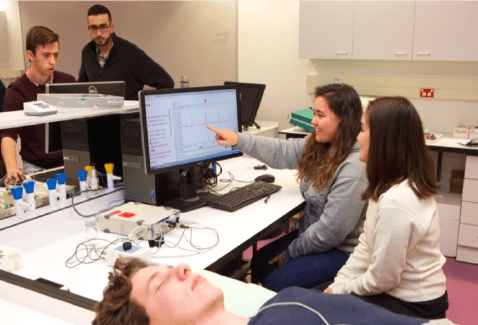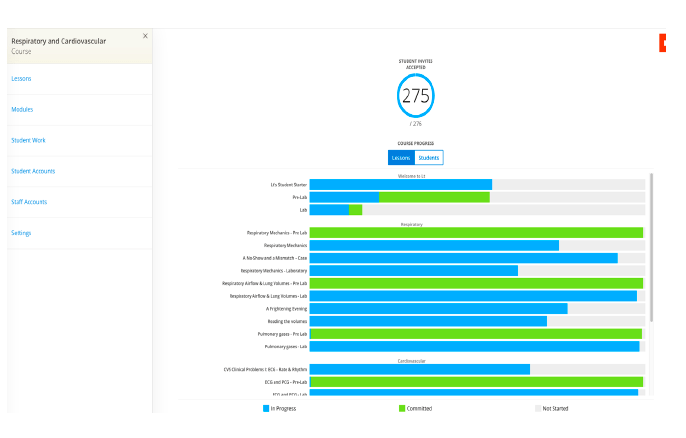Building ‘ako’ in Blended Teaching (Medical and Health Sciences)
Anuj Bhargava from Physiology at the Faculty of Medical and Health Sciences used the Kura Cloud tool in MBChB 221. You will find this useful if you are interested in increasing interactivity in blended learning or if you would like to integrate practical laboratory classes into remote teaching for clinical students.This case also demonstrates how students can become effective partners in design of technology integrated learning. Anuj says: “There was a lot of time spent thinking and drafting how and what to present to the students in this new platform but it was certainly worth the effort.”
KuraCloud is a New Zealand made, cloud-based, e-learning platform that enables teachers to develop interactive lessons. Students can access lessons on their computers and mobile devices, having the freedom to learn at their own pace and in the setting of their choice. Kura Cloud has been shown to be extremely effective at providing a better learning experience for clinical students participating in the practical laboratories. The KuraCloud platform has been used to teach veterinary sciences at Massey University and in some medical schools in the UK and the USA, primarily to teach physiology and functional anatomy. KuraCloud was adapted and implemented in MBChB 221 for the purpose of creating engaging and interactive lessons that would complement the learning based in the laboratory using live data. Caveat: KuraCloud is a licensed platform so there are cost associated with using it in teaching. The usual risks of longevity of the platform and changes to its functionality/features apply as well.
Background
The medical programme was re-invigorated around 2001, shifting from teaching subjects (e.g. anatomy, physiology and biochemistry) in isolation to a more integrated approach. The purpose of the redesign was in part to better prepare students for their future clinical positions. Students in MBChB 221 were having some difficulties putting their learning into a clinical context. Anuj’s role is to facilitate 3-hour long MBChB 221 clinical physiology sessions, which integrate knowledge from many sources. He aims to help students engage with core learning concepts so they leave the lab sessions with the skills and knowledge to apply in future clinical scenarios. As student numbers have increased in recent years, there have been big challenges in continuing to design and run efficiently delivered top quality teaching. The increased workload and the fact that students clearly struggled with the learning demands led to a consideration of how to innovate and rethink the approach in this space.
Design: challenges and process
Despite ensuring a good teacher to student ratio in class, there was often little or no time for students to relate what had happened in the laboratory to the theoretical learning from their lectures and tutorials. Lectures and laboratory sessions had become two disparate learning activities with little or no clinical coherence. As a starting point for the proposed change to teaching in practical laboratories, Anuj wanted to shift from a teacher-centred approach to a student-centred learning environment. He wanted to enable students to acquire a deeper understanding of the subject with a higher level of independence in the learning process (Crawford et al., 1998) while making meaningful connections between theory (lectures/tutorials) and practice (labs). Anuj involved student input right from the start of the design and development of KuraCloud resources. The design involved a blended approach, including web tools to help students build up a good knowledge base and better participate in the laboratories. Three strategies were adopted:
- Active student engagement in acquiring knowledge and skills from/with the lab exercises.
- More student awareness of what they were doing and why with authentic tasks.
- Better interaction with learning resources and tasks.
The laboratories are run in a way that allows students to collect real-life data, offering lessons in scientific technique as well as learning by doing. Students are able to draw conclusions that fit with the concepts they have been learning about. In order for students to collect biological signals a data acquisition system called Powerlab is used. Previously, the data that the students collected in the laboratories had been collated on to the computer program Chart and Scope (or Labchart). This program allowed collected data to be displayed in a way that provided the students with a platform to draw conclusions and to manipulate the data as needed. MBChB students would have to navigate various settings on Scope and Chart to get, for example, ECG output. Instructions for the analysis were provided as a hard-copy lab manual. With multiple steps involved and non-familiarity with the software, students would encounter frequent technical difficulties, making them feel disconnected with the main objective of the lab. The new approach had to make more efficient use of the time spent in the laboratory session and to make the process more engaging for students.
KuraCloud allowed integration of the Powerlab-based data acquisition system into a user-friendly browser-based system. This meant that students could do the pre- laboratory quizzes to prepare for the lab, do the lab on the same platform in a physical space, collect the data and discuss with peers and teaching staff. Seamless integration of pre-lab and laboratory data then helped students cement concepts learned in the lectures and apply them into case studies. This linear integration of knowledge was lacking previously. The case studies on KuraCloud were adapted to become more interactive and self-directed. Anuj added short videos of patients talking about their experiences with health issues which students could easily relate to concepts learned in the lab sessions and their own readings. For these case studies, students were requested to bring their own devices which allowed them to individually log into KuraCloud and work in small groups and discuss the cases with a group of academic staff members. Like the pre-lab quizzes, Anuj also added a section of instant self- assessment questions and feedback to guide students during these sessions. To further develop students’ confidence and independence, on-the-spot tests were dispersed between the various lab activities. This provided an opportunity for students to self-assess and to discuss amongst their group and to clarify concepts with the teaching staff present during the sessions. With re-focussing on learning priorities and keeping student learning interests in the centre there was a move from perceived jargon to simplified and learner-appropriate lessons.The instructions for the laboratories were made clearer, more succinct and embedded within the programme. Pre-lab quizzes and associated short readings were made mandatory. This proved to be a good motivator for most students to prepare for the laboratory sessions. To add meaning to the experience, Anuj carefully integrated tutorials with laboratories to form a logical progression of information and content. He realised the importance for students to keep the use of live practical laboratories and to be able to see clearly the clinical context of the information being learned.
Implementation and evaluation
A group of eight Biomedical Sciences students helped to test and design for good user experience. These students were used to ‘traditional’ laboratory sessions and were interested to observe how the blended approach would work. The feedback helped to further update the lab protocols. Making sure a student-centred approach was kept in mind, a further usability test was done with a group of Stage III MBChB students who had participated in previous versions of clinical physiology laboratory sessions. Anuj also ensured all teachers delivering the programme had training on the platform, including participation in pre-lab quizzes as well as assessments associated with the laboratory so the KuraCloud based approach could achieve its potential.
In June 2017, KuraCloud was introduced to the MBChB 221 class with much anticipation. The laboratory sessions were visible as a preview prior to the laboratories. This meant that students could view videos (that were specifically made, or related copyrighted animations) and read lab protocols prior to attending the session. The videos allowed students to see the setup of the lab equipment prior to the lab session. All 268 MBChB students in the KuraCloud pilot were invited to complete an informal online survey. Anuj had a 41% response rate (111/268 students completed a voluntary survey). Seventy-nine percent of these completed the open-text questions at the end, which was very encouraging considering participation was completely voluntary. The online questionnaire’s 13 questions probed the various aspects of the design of the new blended environment, including the ease of finding information, ease of using the online lab elements and extent to which content was well pitched.
What worked well?
Anuj reflects: “With any new innovative method of teaching and learning, one is usually very apprehensive about its likely success. My apprehension was very short-lived after I witnessed students really embracing the new blended approach. My first observations were of preparedness in terms of doing the pre-lab quizzes and reading around the content. Despite not having seen the lab equipment prior to coming to the laboratories, students independently engaged with the protocols and attempted self-directed questions. Students were able to do a lot of trouble- shooting by themselves, which meant that teaching facilitators had time to discuss the relevant physiological concepts, rather than attend to problems with student use of equipment or software. It felt as if I had switched the ‘magic button’ to turn disengaged to very engaged students keen to making clinical connections with lab activities. Students appeared independent, engaged and synthesising new knowledge. It was made very clear by the informal student commentaries during class that they found the online laboratories were stimulating and valuable to encourage deep learning.”
What would be done differently?
Anuj reflects: “My innovation is not restricted to physiology laboratories. I intend to use it in other courses that would benefit from a blended-learning approach. I have already implemented a KuraCloud based lab session for an MBChB Nutrition module as well as in the Bachelor of Pharmacy programme. I am also in the process of developing a KuraCloud based case-study for a second year MBChB paper, Principles of Medicine. Intentions are to promote this innovation to other schools that might be considering case based self-directed learning approach in the future. I presented my innovation at the Faculty’s teaching-learning showcase earlier this year and this has led to wider university interest in its implementation.”
Further resources:
International Symposium (Remote) for Online Physiology Teaching I (Video) International Symposium (Remote) for Online Physiology Teaching I (Video)

